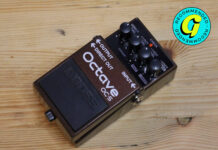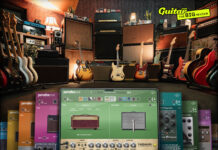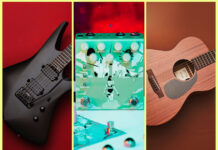
15 best electric guitars under $500
Whether you’re on a strict budget for your first axe or you’re looking for a project guitar, here are our picks of the best electric guitars under $500.
We picked these guitars based on two main criteria: their ‘uniqueness’ and the value of their feature set, construction and specs. As you’d expect, Asia-made models from big brands dominate this list. And that’s simply because they’re able to produce good quality at immense economies of scale.
Schecter C-1
The Schecter Stealth C-1 is more than a ‘metal guitar’. The South Korea-made six-string comes with a host of features and specs that make it fairly versatile for most schools of rock. And, at just under $500 for a well-constructed model, the Stealth C-1 represents great value for money, too.
Highlights
Beautiful bound body
Shred-friendly: ultra-smooth satin-finished neck, very flat fretboard radius and 24 extra jumbo frets
Coil-split Schecter Diamond SuperRock-II humbuckers
Hardtail string-through bridge
Retails for $500
The Stealth C-1 is a robust instrument whose simplicity is reflected in its design. An arched top, subdued finishes, subtle fretboard inlays, a bound body and all-black hardware complement its mahogany body and set neck. This is not a guitar that tries too hard to be something it isn’t.
In this case, it’s all about rock and metal. That’s thanks to the Schecter Diamond SuperRock-II humbuckers that offer straightforward fat, hot tones – but they’re also coil-split, opening up another world of single-coil sounds. As with most budget pickups, these humbuckers aren’t the most articulate or nuanced around. Yet, with ample amounts of distortion, they’ll get the job done.
The thin C-shaped satin-finished neck with a 14-inch-radius rosewood fretboard and 24 extra jumbo frets lend the Stealth C-1 more shred cred. But while there isn’t a trem system here, a string-through-body hardtail bridge is a decent trade-off.
Gretsch G2420T Streamliner
You’d be hard-pressed to find another electric guitar under $500 with the bold and commanding looks of a big ol’ Gretsch. The Gretsch GG2420T Streamliner brings you all of Gretsch’s resonant, semi-hollow tones, fetching appearance and vintage, Rockabilly vibes in a package that’s light on yor wallet.
Highlights
Laminate maple semi-hollow build with parallel bracing
Vintage good looks with a bound body and neck
Two Broad’Tron humbuckers produce bright and throaty tones
Chunky U-shaped neck with a 12-inch-radius laurel fretboard
Retails for just shy of $500
This Indonesian made model is was launched in 2016 and upgraded earlier this year. A new range of colours was introduced, along with aged multi-ply binding, tortoiseshell pickguards, hump block inlays for the hollow bodies and larger f-holes.
The original Tim Shaw designed Broad’Tron pickups have been updated to create the Broad’Tron BT-2S, with reconfigured windings to improve clarity while increasing output and punch.
The Streamliner is a bona-fide archtop, with two braces glued to the underside of the top and also features a chunky neck with a deep ‘U’ shape. Tonally it’s also loud, bright and with plenty of depth. There’s a percussive attack, plenty of harmonic content and a frequency range that can easily compete with the higher priced Electromatic and Players Edition models.
The Gretsch GG2420T Streamliner is incredible value for money and a wonderful entrée into the diverse world of Gretsch instruments. There’s a plethora of colour options on offer and the ability to upgrade parts simply, if you’re partial to some tweaking.
Squier Classic Vibe ’50s Telecaster
The Squier Classic Vibe ’50s Telecaster is a classic that’s well within your price range. The budget Tele is a guitar built for more wallet conscious players, but fully equipped with the vintage feel of a true “blackguard.”. You’d struggle to ignore its achingly cool looks too, with its maple neck and butterscotch blonde body.
Highlights
Vintage style bridge
Alnico V single-coil pickups
Butterscotch blonde over pine body
Retails for about $450
Featuring a pine body in place of alder, and its alnico V single coil pups, this guitar bleeds classic Fender tones. But this Tele is still comfortable to play and more than capable of producing the rich, meaty tones of punk, classic rock, indie rock and other guitar driven genres shy of extreme metal.
Simple Tele-style controls – three-way switch plus master volume and tone knobs – are all you have to contend with. The Classic Vibe ’50s Telecaster also has a vintage style bridge, modern C shaped neck profile and 9.5″-radius maple fretboard for more modern playability. These result in a guitar that’s ideal for classic and modern styled players that still admire the classic looks of a Tele.
Danelectro ’59XT
An upgrade on a previous Jimmy Page model, you’ll be forgiven if this one feels similar. Despite its similarities The ’59XT is, thanks to its offset pickups, a more aggressive beast altogether. If you’re looking for something outside of the atypical Strat or Les Paul sphere, you’d be hard-pressed to find a guitar as unique and eccentric as this for under $500.
Highlights
Vintage-inspired looks
High-output P-90 (neck) and classic lipstick humbuckers (bridge)
Wilkinson tremolo bridge for versatility and stability
Maple neck and rosewood fretboard on a semi-hollow body
Retails for $499
Snobs may scoff at the ’59XT’s chambered Masonite body but plug the guitar in, crank it up and the rich, wide and velvety tones that it’s capable of will zip the lips of any naysayer. It’s a guitar that’s great for old-school rock, punk and other jangly genres.
Slapped onto its semi-hollow body is a P-90 and a lipstick humbucker, the latter of which is coil-split. Both are known for their slightly dirty tone and musical midrange bump, and both pickups are offset: the treble end of the humbucker is tilted towards the bridge, and vice-versa for the P-90. This evens out the tone of the bass and treble strings, especially when you’re strumming.
The other highlight on this guitar is its smooth and sensitive Wilkinson tremolo system. This allows for deep dives and warped pitch changes that frequently appear on anything from surf to psychedelic to new wave.
The ’59XT isn’t the most versatile guitar, even at the $500 mark. But as a dedicated axe for rock that drips with retro coolness, it doesn’t get much more value-for-money than this.
Yamaha Revstar RS420
Another slightly left-field choice, the Yamaha Revstar RS420 is a guitar that punches well above its weight. This dual-cutaway instrument is meant for the brawny, visceral tones of rock ’n’ roll – think AC/DC, Badfinger and even Cream. Yamaha is a brand renowned for its build quality, and that reputation is maintained with this sub-$500 offering.
Highlights
A robust, stripped-down instrument that can nail most styles of rock
Two vintage-output YGD Alnico V humbuckers
Push/pull “Dry Switch” splits the humbuckers but also filters out bass frequencies for punch and clarity
Retails for just under $500
Inspired by racer motorcycles of the 60s, the Indonesia-made RS420 is a performance instrument through and through. Its understated looks belie its muscle: two YGD alnico V humbuckers (VH3 models) are specially wound for the Revstar series, and yield those distinct tones you’ve heard on countless classic rock records. A Yamaha-exclusive “Dry Switch” splits the coils without the hum, and cuts the low frequencies so those single-coil sounds are as punchy and clear as they should be.
While the tonewoods used are modest – the RS420 has a maple-topped nato body and nato neck – it’s a comfortable guitar to play. Yamaha installed a belly cut and kept the slim set neck extremely accessible all the way to the higher frets.
A 13.75-inch-radius rosewood fretboard, 22 medium jumbo frets and 24.75-inch scale length round up the other specs on this guitar. A Tune-o-Matic bridge, stopbar tailpiece and chrome tuners are the other components decent enough for an under-$500 guitar.
PRS SE Standard 24
Formally regarded as the company providing guitars for bankers and dentists, PRS revealed the SE range in 2001 to critical acclaim, offering incredible build quality and craftsmanship that bellies its price tag. And the 2019 PRS SE Standard 24 continues the series’ reputation for being solid, well-crafted, versatile and affordable guitars.
Highlights
Bound mahogany body available in three finishes equipped with PRS bird inlays
Coil-split pickups for versatility
Maple Wide Thin set neck, rosewood fretboard
Nickel PRS patented tremolo
Retails for about $500
The SE Standard 24 is the ‘budget’ version of the Custom 24, which is PRS’ flagship instrument. Besides their almost-identical looks (save for the Custom’s carved figured maple top), both guitars are some of the most versatile instruments in their price ranges. Blues, rock, metal, shoegaze, ambient – you name it, the SE Standard 24 can handle it.
The 85/15 “S” humbuckers here are affordable versions of the Custom’s 85/15, and are transparent, ‘hi-fi’, articulate and high-output. Additionally, the pickups have been coil-split to take you into glassier, single-coil territory. However, you can’t coil-split them individually to form HS or SH combinations, for instance.
Even its other features don’t lean towards a specific style of playing. The SE Standard 24 has a very thin neck profile, moderate 10-inch fretboard radius, 25-inch scale, 24 frets and a moulded tremolo that, like the guitar as a whole, is well worth its price tag of under $500.
Sterling by Music Man Cutlass SSS
With a pedigree that goes back to Leo Fender himself, the Cutlass by Music Man is an obvious Strat-inspired model, but with modern upgrades and player-friendly touches. With a slightly more curvaceous body, there’s little to seperate these budget instruments from their American counterparts.
Highlights
Solid poplar body
Great colour choices
Two-point vibrato with screw in trem
Flat 12″ radius
Retails for about $350
By paying about 20 percent of the price of a US-made Music Man, compromises can be expected. These Sterling versions posess poplar bodies instead of alder, more basic hardware and unnamed pickups. There’s also a much more limited colour range, with just two options on offer: Charcoal Frost or Daphne Blue for the SSS. And while both necks are maple, the fretboard here is laurel, rather than rosewood.
With a satin neck and a gently curved neck joint, this guitar is extremely playable, and comes sporting a fine factory setup, too. The five-bolt neck features a 12″ radius fingerboard, catering more to modern players than those that are vintage inclined. But then, the later probably wouldn’t pick up a Sterling model anyhow. This is a low-cost Strat alternative with pickups that err on the chunky side.
Squier Classic Vibe ’60s Jazzmaster
If you’re lusting over an original Jazzmaster but don’t want to plonk down thousands of bucks for it, the Squier Classic Vibe ’60s Jazzmaster is right up your alley. The offset guitar retains many of the old-school specs that made the model famous back in the day, with a few modern enhancements to appeal to contemporary players.
Highlights
Original rhythm and lead circuits, and their corresponding controls
Fender Designed alnico pickups
Floating vibrato system, just like on a traditional Jazzmaster
Lightweight poplar body
Slim C-shaped neck and vintage gloss finish
Retails for under $400
Despite its low price, this is not a guitar for newbies. The circuitry’s complex, the bridge is notoriously wonky, and it feels huge when you’re playing sitting down. This is the most authentic Jazzmaster you can get for under $500.
The Classic Vibe Jazzmaster has the tried-and-tested dual circuitry of the original models from the 60s. The Rhythm circuit activates only the neck pickup, while the Lead circuit lets you pick between neck, bridge and both at the same time. Each circuit has its own dedicated master volume and tone knobs. (In comparison, even Fender American Professional Jazzmasters don’t have this circuitry.)
Depending on which side of the fence you’re on, you may love or hate the floating vibrato system and vintage-style bridge on this Jazzmaster. Some consider the grooved barrel saddles unstable, while others believe they contribute to the Jazzmaster’s signature low sustain and sonic artefacts.
There’s more vintage inspiration on offer, too. A pair of Fender designed single-coils give this Squier that coveted clear, syrupy and mellow Jazzmaster tone that works brilliantly with effects – which is one reason why you’ll find many shoegazers, post-rockers and experimental musicians toting this iconic axe. It also features nickel plated hardware and a vintage gloss finish for a’60s styling.
Epiphone G-400 PRO
The Epiphone G-400 PRO is to a Gibson SG what a Squier Contemporary Stratocaster is to its American Original Fender counterpart. Far more affordable and arguably more versatile than the Gibson, yet it looks almost identical. So while the G-400 PRO has the tone, feel and aesthetics of a rock ’n’ roll beast, it packs a few surprises up its sleeves.
Highlights
Split-coil Epiphone Alnico Classic PRO humbuckers
Classic SG looks that guitar deities Angus Young and Tony Iommi helped popularise
Mahogany body that won’t weigh you down
Retails for about $350
We won’t waste your time with words on how and why the SG is as iconic as it is. But if you consider the G-400 PRO a pale imitation of its Gibson sibling, think again. This axe, which will set you back under $500, can rock.
Besides the solid mahogany body, the two Epiphone Alnico Classic PRO humbuckers are hugely responsible for the guitar’s characteristic growling, almost ‘honky’, tone with rather brash trebles. They have alnico V magnets, which yield a tight response and are perfect for crunchy rock rhythms à la AC/DC.
But the pickups are also where the G-400 goes a step beyond the SG. Both humbuckers are coil-split, which, in combination with a three-way pickup selector switch and two push/pull knobs, open up a whole new palette of sounds. Eight, to be precise. Go from the sizzling cleans of a neck single-coil, to the dirt of the bridge humbucker, to the power of both humbuckers in tandem – or anything in-between.
The other big difference between this and a Gibson is its neck. Where the Gibson uses a C-shaped SlimTaper profile, the G-400 has a D-shaped one. It isn’t quite as fast, but the thick ‘shoulders’ of the G-400’s neck make this model generally more comfortable when holding down power or barred chords.
ESP LTD EC-256
The EC-256 is ESP’s entry-level version of its Eclipse line. And while it’s no mystery where it draws its good looks from, don’t let that distract you from what makes it a great guitar under $500. Everything about the EC-256 is decidedly modern, and can take you from blues to rock to metal, easy.
Highlights
Single-cutaway with mahogany body and three-piece mahogany set neck
Blackwood or jatoba fretboard
Thin U-shaped neck for fast playing and comfort
22 extra jumbo frets
Coil-split ESP LH-150 pickups
Retails for under $400
The EC-256 is reminiscent of a Les Paul Black Beauty, and has very similar specs: a mahogany body and set neck, 24.75-inch scale, a Tune-o-Matic bridge, and a pair of humbuckers, in this case the ESP Designed LH-150. The pickups here are a tad muddy when played clean, even when split, but they’re easily swapped out, anyway.
While it may resemble a Les Paul, the EC-256 isn’t quite as traditional. Many features on the guitar are better suited for today’s players: a thin U-shaped neck that’s faster to play on, a flatter fretboard radius of about 14 inches, 22 extra jumbo frets, and coil-split humbuckers. A deeper cutaway also makes reaching those higher frets easier.
Fender Duo-Sonic HS
With a burgeoning resurgance of 1990s rock and Britpop, how does Fender aim to stay relevant with the millenials and gen zers? Simply reissue the classic Duo-Sonic, of course. Born in 2016, the Duo-Sonic HS is a student model that echos the model’s original 1956 body shape with a waist that’s higher on the bass side and much closer to symmetrical than the Mustang’s, which is a true offset.
Highlights
Short-scale playability
Single coil neck and bridge humbucker aids versatility
Push-pull knobs ensure its not a one trick pony
Retails for about $400
This short-scale six-string electric has a Strat-style hardtail bridge with bent steel saddles and a similar C-shaped, satin polyurethane-finished neck with 22 medium-jumbo frets and 9.5-inch fingerboard radii.
Descended from student models it be, but this killer guitar is compact, robust and optimised for high-energy stage performances. The build quality is consistently neat across the range, and we find very little to complain about, especially in this price bracket.
The Duo-Sonic HS is brash, with a natural jangle and plenty of air on offer. The neck single coil delivers plenty of snap, while pulling the tone pot splits the bridge humbucker for hollower, springier single-coil sounds. It suits funky and choppy styles, just as well as ’90s grunge (provided you have a DS-2 to hand) and the Duo-Sonic’s bright attack is almost exactlywha t we’d expect from a Fender at a much higher price point.
Jackson King V JS32T
If a Gibson Flying V isn’t demonic looking enough for you, then we have the answer. This particular model, the Jackson King V JS32T, is the brand’s wallet-friendly version of one of its bestsellers. And as you can probably tell from its striking shape, expect this to get loud and heavy.
Highlights
‘Sharp’ Flying V shape, all-black hardware and pearloid sharkfin inlays
For shredders: compound radius fretboard
High-output Jackson humbuckers voiced for richness, sustain and overdriven tones
Graphite-reinforced neck and amaranth fretboard
Retails for about $250
Frankly, besides body shape, there’s not a lot that separates the JS32T from the other Jackson budget favourite, the JS22 Dinky. They both have poplar bodies, maple necks, a compound fretboard radius of 12 to 16 inches, and a pair of Jackson High-output Humbuckers, among other identical specs. The compound radius is an important one, though: it means you’ll feel as comfortable holding down chords as you would soloing on the upper registers.
But the devil is in the details. The JS32T doesn’t have a tremolo system, making up for that with a string-through body, Tune-o-Matic bridge, and a slightly slimmer maple ‘speed’ neck.
A word of warning, though: King Vs don’t sit on your lap like most guitars do, so don’t shoot for this piece unless you enjoy playing while standing. But if that’s not a problem for you, then all you’ve got to worry about is deciding between Ferrari Red and Gloss Black, the two slick finishes for this eye-catching instrument.
Squier Classic Vibe 50s Stratocaster
There isn’t much to say about a Stratocaster that hasn’t already been hammered home over the 50 years since it made its debut. Fender’s flagship instrument shares the same reputation as a Les Paul: they’re the most iconic electric guitars ever. And the Squier Classic Vibe 50s Stratocaster is one of the best value-for-money Stratocasters available on today’s market.
Highlights
Plays and feels like a high-end Strat at a fraction of the cost
Has a 9.5-inch fretboard radius that’s neither too flat nor too curved
Three alnico III single-coils emulate a 50s-era tone
Retails for under $400
This model encapsulates a Strat’s reputation of being a versatile guitar that can swerve from rock to blues to funk to ambient – and everything in-between.
The three alnico III single-coils, wired up in five positions, are partly responsible for that. You can go from glassy tones of the neck pickup to the bite of the bridge pickup to the ‘quacks’ of the positions in-between, the latter of which refers to two single-coils activated in tandem.
Like many Fender Strats, the Classic Vibe 50s has a lightweight alder body, maple neck and maple fretboard. Its C-shaped neck and 9.5-inch fretboard radius mean it’s comfortable for both rhythm and lead playing, while a vintage-style synchronised tremolo bridge makes the guitar even more of an all-rounder.
Wondering about the differences between the Classic Vibe 50s and the Classic Vibe 60s? Cosmetics notwithstanding, the latter has hotter alnico V single-coils and an Indian laurel fretboard. Everything else – including their under-$500 price tags – is identical.
Epiphone Les Paul Standard
Alongside the Stratocaster, Les Pauls have almost entirely defined rock ’n’ roll. Everyone from Jimmy Page to Taylor Swift has wielded one of these, and the guitar’s fat, creamy tone with near-endless sustain is instantly recognisable. If you’re not looking to spring for a bona fide Gibson, the Epiphone Les Paul Standard is your next best bet.
Highlights
A pair of warm, fat-sounding Alnico Classic and Alnico Classic Plus humbuckers
Robust mahogany body with a solid maple top
1960s slim-taper neck profile
Retails for just under $500
Epiphone Les Paul Standards are built in China, South Korea or Indonesia. They no longer come with figured maple tops (you’ll find those on the Plustop PRO models), but have the cream neck and body binding, chrome pickup covers, and trapezoid inlays of their Gibson cousins. In other words, they’re drop-dead gorgeous.
They don’t just look the part, either. Epiphone Les Paul Standards come with an Alnico humbucker at the neck and Alnico Classic humbucker at the bridge, which yield the classic thick, saturated tone Les Pauls are renowned for. And like a Gibson, these Les Pauls have a set of volume and tone knobs for each pickup.
The other specs on these also mimic those of a Gibson: a mahogany body and set neck, 12-inch fretboard radius, 24.75-inch scale, and Tune-o-matic bridge, among others. If you’re hankering after a rock-ready guitar that won’t break the bank, the Epiphone Les Paul Standard should top your list.
Ibanez S521
A long-standing member of the Ibanez faimly, the S521 is a dependable, robust six-string that’s ever so slightly geared towards metal and rock thanks to its pickups, yet remains accesible to all thanks to its six-saddle bridge system and thin, fast neck. Beginner guitarists eager to dive into those heavier genres will find plenty to love about this axe.
Highlights
Sophisticated good looks with a sculpted top
Two Ibanez Quantum humbuckers with heightened bass
Meranti body, maple neck and jatoba fretboard
Fixed bridge for easy usability
For shredders and beginners: very fast neck, flat fretboard radius and two-octave range
Retails for about $500
Simplicity lies at the heart of the S521. Its pair of Quantum humbuckers are responsible for most of its ‘high-definition’ tone. These pickups offer a heightened bass response with a full midrange and articulate highs, perfect for those palm-muted riffs and screaming solos. You can also engage the neck humbucker’s coils in parallel, which gives the pickup a brighter, single-coil-ish bite.
The Wizard III maple neck on the guitar is built for shred players, too. It’s thin and has a very flat 15.8-inch fretboard radius – not to mention 24 jumbo frets – that your hands and fingers will have no problem gliding across. Add in the fixed bridge for added tuning stability and beginners and pros alike will be able to shred into eternity without a care.
Check out our other lists on the best beginner’s guitars, instruments under $200, intermediate guitars and value-for-money axes.
The post 15 best electric guitars under $500 appeared first on Guitar.com | All Things Guitar.
Source: www.guitar-bass.net











